Askeland D.R., Fulay P.P. Essentials of Materials Science & Engineering
Подождите немного. Документ загружается.

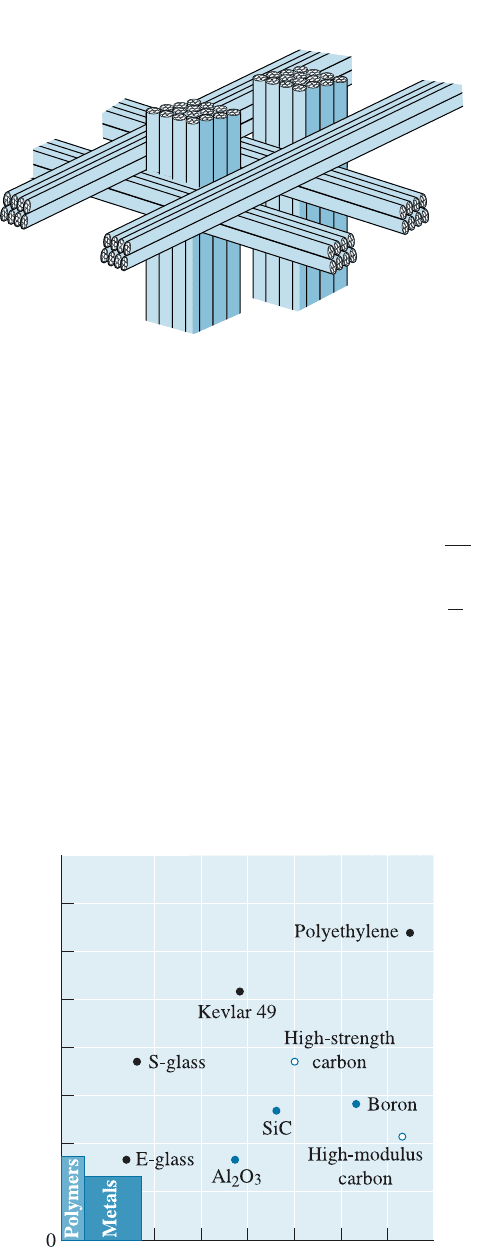
Fiber Properties In most fiber-reinforced composites, the fibers are strong, sti¤, and
lightweight. If the composite is to be used at elevated temperatures, the fiber should also
have a high melting temperature. Thus the specific strength and specific modulus of the
fiber are important characteristics:
Specific strength ¼
TS
r
ð17-11Þ
Specific modulus ¼
E
r
ð17-12Þ
where TS is the tensile strength, r is the density, and E is the modulus of elasticity.
Properties of typical fibers are shown in Table 17-2 and Figure 17-14. Note in
Table 17-2, the density is in g/cm
3
. The highest specific modulus is usually found in
materials having a low atomic number and covalent bonding, such as carbon and
boron. These two elements also have a high strength and melting temperature.
Figure 17-13
A three-dimensional weave for
fiber-reinforced composites.
Specific strength (3 10
6
cm)
Specific modulus (3 10
8
cm)
5
2.5 5 7.5 10 12.5 15 17.5
10
15
20
25
30
35
Figure 17-14
Comparison of the specific strength
and specific modulus of fibers
versus metals and polymers.
C HA P T E R 1 7 Composites: Teamwork and Synergy in Materials560

Aramid fibers, of which Kevlar
TM
is the best known example, are aromatic poly-
amide polymers strengthened by a backbone containing benzene rings (Figure 17-15)
and are examples of liquid-crystalline polymers in that the polymer chains are rod-
like and very sti¤. Specially prepared polyethylene fibers are also available. Both the
aramid and polyethylene fibers have excellent strength and sti¤ness but are limited to
low-temperature use. Because of their lower density, polyethylene fibers have superior
specific strength and specific modulus.
TABLE 17-2 9 Properties of selected reinforcing materials*
Tensile Modulus of Melting Specific Specific
Density Strength Elasticity Temperature Modulus Strength
Material (g/cm
3
) (MPa) (D10
3
MPa) (
˚
C) (D10
7
cm) (D10
6
cm)
Polymers:
Kevlar
TM
1.44 4480 124 500 86.8 31.3
Nylon 1.14 83 3.5 249 2.5 7.3
Polyethylene 0.97 21–48 0.3–0.7 147 17.8 34.3
Metals:
Be composites 1.83 276–345 303 1277 193.8 7.0
Boron 2.36 3450 379 2030 161.8 11.8
W 19.40 4000 407 3410 21.3 2.0
Glass:
E-glass 2.55 3450 72.4 <1725 28.5 14.0
S-glass 2.50 4480 86.9 <1725 35.0 18.0
Carbon:
HS (high strength) 1.75 5650 276 3700 158.8 32.5
HM (high modulus) 1.90 1860 531 3700 280.0 9.8
Ceramics:
Al
2
O
3
3.95 2070 379 2015 97.0 5.3
B
4
C 2.36 2280 483 2450 206.0 9.8
SiC 3.00 3930 483 2700 118.3 13.3
ZrO
2
4.84 2070 345 2677 71.5 4.3
Whiskers:
Al
2
O
3
3.96 20700 428 1982 108.5 52.5
Cr 7.20 8900 241 1890 33.5 12.3
Graphite 1.66 20700 703 3700 425.0 125.5
SiC 3.18 20700 483 2700 152.0 65.5
Si
3
N
4
3.18 13800 379 119.5 43.8
Figure 17-15
The structure of
Kevlar
TM
. The fibers are
joined by secondary
bonds between oxygen
and hydrogen atoms on
adjoining chains.
17-4 Chara cteristics of Fiber-Reinforced Composites 561

Ceramic fibers and whiskers, including alumina, glass, and silicon carbide, are strong
and sti¤. Glass fibers, which are the most commonly used, include pure silica, S-glass
(25% Al
2
O
3
, 100% MgO, balance SiO
2
), and E-glass (18% CaO, 15% Al
2
O
3
, balance
SiO
2
). Although they are considerably denser than the polymer fibers, the ceramics can
be used at much higher temperatures. Beryllium and tungsten, although metallically
bonded, have a high modulus that makes them attractive fiber materials for certain ap-
plications. The following example discusses issues related to designing with composites.
EXAMPLE 17-9
Design of an Aerospace Composite
We are now using a 7075-T6 aluminum alloy (modulus of elasticity of
69 10
3
MPa to make a 227 kg panel on a commercial aircraft. Experience
has shown that each kg reduction in weight on the aircraft reduces the fuel
consumption by 4200 litres each year. Design a material for the panel that will
reduce weight, yet maintain the same specific modulus, and will be economical
over a 10-year lifetime of the aircraft.
SOLUTION
There are many possib le materials that might be used to provide a weight
savings. As an example, let’s consider using a boron fiber-reinforced Al-Li al-
loy in the T6 condition. Both the boron fiber and the lithium alloying addition
increase the modulus of elasticity; the boron and the Al-Li alloy also have
densities less than that of typical aluminum alloys.
The specific modulus of the current 7075-T6 alloy is:
Specific modulus ¼
ð69 10
3
MPaÞ
2:7
g
cm
3
¼ 2:61 10
8
cm
The density of the boron fibers is approximately 2.36 g/cm
3
and that of a
typical Al-Li alloy is approximately 2.5 g/cm
3
. If we use 0.6 volume fraction
boron fibers in the composite, then the density, modulus of elasticity, and spe-
cific modulus of the composite are:
r
c
¼ð0:6Þð2:36Þþð0:4Þð2:5Þ¼2:416 g=cm
3
E
c
¼ð0:6Þð379 10
3
MPaÞþð0:4Þð76 10
3
MPaÞ¼258 10
3
MPa
Specific modulus ¼
258 10
3
MPa
2:416 g=cm
3
¼ 10:9 10
8
cm
If the specific modulus is the only factor influencing the design of the
component, the thickness of the part might be reduced by 75%, giving a com-
ponent weight of 56.8 kg rather than 227 kg. The weight savings would then be
170.2 kg, or (4200 litres/kg)(170.2 kg) ¼ 714,840 litres per year. At about $.50
per litre, about $357,000 in fuel savings could be realized each year, or $3.57
million over the 10-year aircraft lifetime.
C HA P T E R 1 7 Composites: Teamwork and Synergy in Materials562

This is certainly an optimistic comparison, since strength or fabrication
factors may not permit the part to be made as thin as suggested. In addition,
the high cost of boron fibers (over $660/kg) and higher manufacturing costs
of the composite compared with those of 7075 aluminum would reduce cost
savings. As mentioned before, Boeing has used 50% carbon-fiber-reinforced
plastic in its latest 787 Dreamliner airplane to achieve 20% increase in fuel
e‰ciency.
Matrix Properties The matrix supports the fibers and keeps them in the proper position,
transfers the load to the strong fibers, protects the fibers from damage during manu-
facture and use of the composite, and prevents cracks in the fiber from propagating
throughout the entire composite. The matrix usually provides the major control over
electrical properties, chemical behavior, and elevated-temperature use of the composite.
Polymer matrices are particularly common. Most polymer materials—both ther-
moplastics and thermosets—are available in short glass fiber-reinforced grades. These
composites are formed into useful shapes by the processes described in Chapter 16.
Sheet-molding compounds (SMCs) and bulk-molding compounds (BMCs) are typical
of this type of composite. Thermosetting aromatic polyimides are used for somewhat
higher temperature applications.
Metal-matrix composites include aluminum, magnesium, copper, nickel, and inter-
metallic compound alloys reinforced with ceramic and metal fibers. A variety of aero-
space and automotive applications are satisfied by the MMCs. The metal matrix
permits the composite to operate at high temperatures, but producing the composite is
often more di‰cult and expensive than producing the polymer-matrix materials.
The ceramic-matrix composites (CMCs) have good properties at elevated temper-
atures and are lighter in weight than the high-temperature metal-matrix composites. In
a later section, we discuss how to develop toughness in CMCs.
Bonding and Failure Particularly in polymer and metal-matrix composites, good
bonding must be obtained between the various constituents. The fibers must be firmly
bonded to the matrix material if the load is to be properly transmitted from the matrix
to the fibers. In addition, the fibers may pull out of the matrix during loading, reducing
the strength and fracture resistance of the composite if bonding is poor. Figure 17-16 on
the next page illustrates poor bonding of carbon fibers in a copper matrix. In some
cases, special coatings may be used to improve bonding. Glass fibers are coated with a
silane coupling or ‘‘keying’’ agent (called sizing) to improve bonding and moisture re-
sistance in fiberglass composites. Carbon fibers are similarly coated with an organic
material to improve bonding. Boron fibers have been coated with silicon carbide or
boron nitride to improve bonding with an aluminum matrix; in fact, these fibers have
been called Borsic fibers to reflect the presence of the silicon carbide (SiC) coating.
Another property that must be considered when combining fibers into a matrix is
the similarity between the coe‰cients of thermal expansion for the two materials. If the
fiber expands and contracts at a rate much di¤erent from that of the matrix, fibers may
break or bonding can be disrupted, causing premature failure.
In many composites, individual plies or layers of fabric are joined. Bondi ng
between these layers must also be good or another problem—delamination—may occur.
Delamination has been suspected to be a cause in some accidents involving airplanes
using composite-based structures. The layers may tear apart under load and cause fail-
ure. Using composites with a three-dimensional weave will help prevent delamination.
17-4 Chara cteristics of Fiber-Reinforced Composites 563
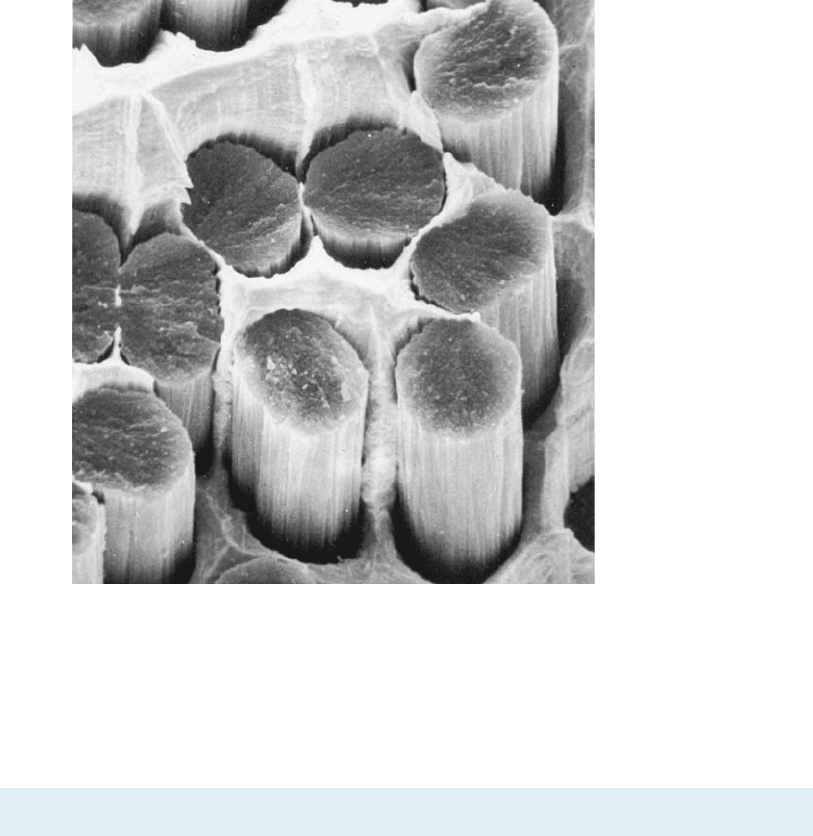
17-5 Manufacturing Fibers and Composites
Producing a fiber-reinforced composite involves several steps, including producing the
fibers, arranging the fibers into bundles or fabrics, and introducing the fibers into the
matrix.
Making the Fiber Metallic fibers, glass fibers, and many polymer fibers (including
nylon, aramid, and polyacrylonitrile) can be formed by drawing processes, as described
in Chapter 8 (wire drawing of metal) and Chapter 16 (using the spinnerette for polymer
fibers).
Boron, carbon, and ceramics are too brittle and reactive to be worked by conven-
tional drawing processes. Boron fiber is produced by chemical vapor deposition (CVD)
[Figure 17-17(a)]. A very fine, heated tungsten filament is used as a substrate, passing
through a seal into a heated chamber. Vaporized boron compounds such as BCl
3
are
introduced into the chamber, decompose, and permit boron to precipitate onto the
tungsten wire (Figure 17-18). SiC fibers are made in a similar manner, with carbon
fibers as the substrate for the vapor deposition of silicon carbide.
Figure 17-16 Scanning electron micrograph of the fracture surface of a silver-copper alloy
reinforced with carbon fibers. Poor bonding causes much of the fracture surface to follow the
interface between the metal matrix and the carbon tows (3000). (From Metals Handbook,
American Society for Metals, Vol. 9, 9th Ed., 1985.)
C HA P T E R 1 7 Composites: Teamwork and Synergy in Materials564
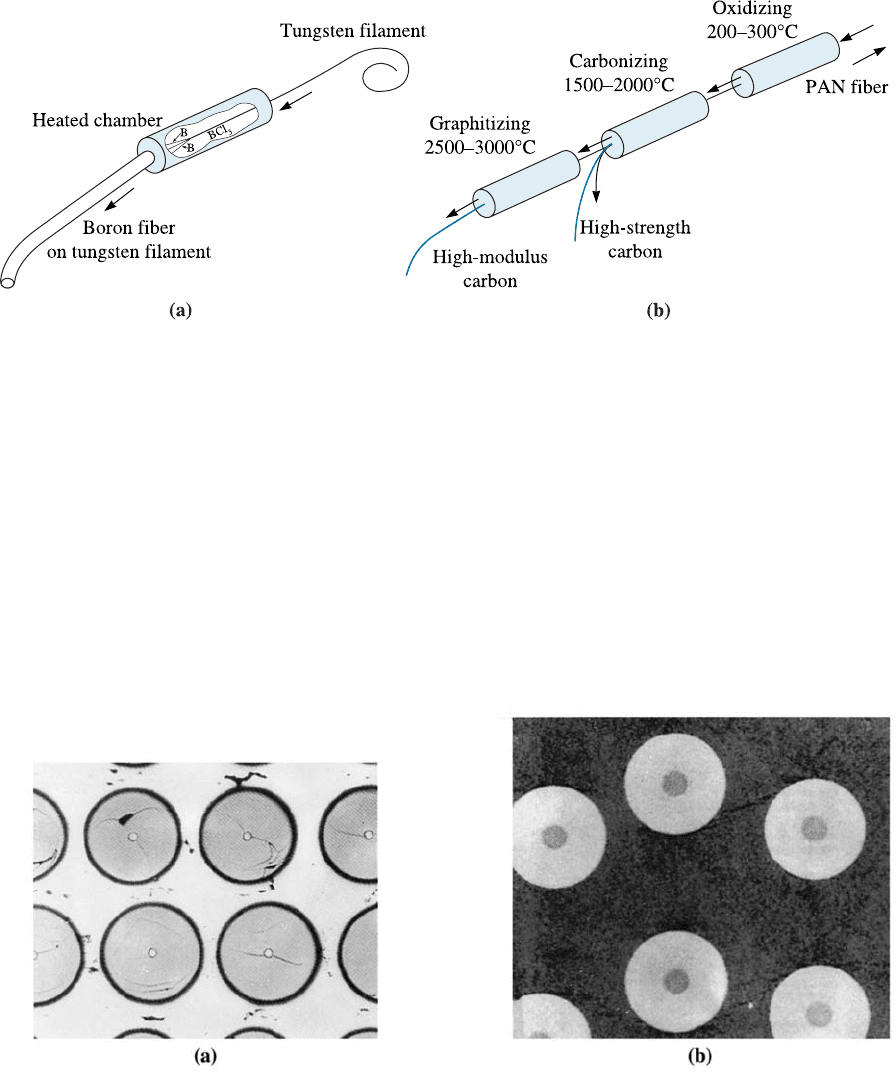
Carbon fibers are made by carbonizing, or pyrolizing, an organic filament, which is
more easily drawn or spun into thin, continuous lengths [Figure 17-17(b)]. The organic
filament, known as a precursor, is often rayon (a cellulosic polymer), polyacrylonitrile
(PAN), or pitch (various aromatic organic compounds). High temperatures decompose
the organic polymer, driving o¤ all of the elements but carbon. As the carbonizing
temperature increases from 1000
C to 3000
C, the tensile strength decreases while the
modulus of elasticity increases (Figure 17-19 on the next page). Drawing the carbon
filaments at critical times during carbonizing may produce desirable preferred ori-
entations in the final carbon filament.
Whiskers are single crystals with aspect ratios of 20 to 1000. Because the whiskers
contain no mobile dislocations, slip cannot occur and they have exceptionally high
strengths. Because of the complex processing required to produce whiskers, their cost
may be quite high.
Figure 17-17 Methods for producing (a) boron and (b) carbon fibers.
Figure 17-18 Photomicrographs of two fiber-reinforced composites: (a) In Borsic fiber-
reinforced aluminum, the fibers are composed of a thick layer of boron deposited on a small-
diameter tungsten filament (1000). (From Metals Handbook, American Society for Metals,
Vol. 9, 9th Ed., 1985.) (b) In this microstructure of a ceramic-fiber–ceramic-matrix composite,
silicon carbide fibers are used to reinforce a silicon nitride matrix. The SiC fiber is vapor-
deposited on a small carbon precursor filament (125). (Courtesy of Dr. R.T. Bhatt, NASA
Lewis Research Center.)
17-5 Manufacturing Fibers and Composites 565
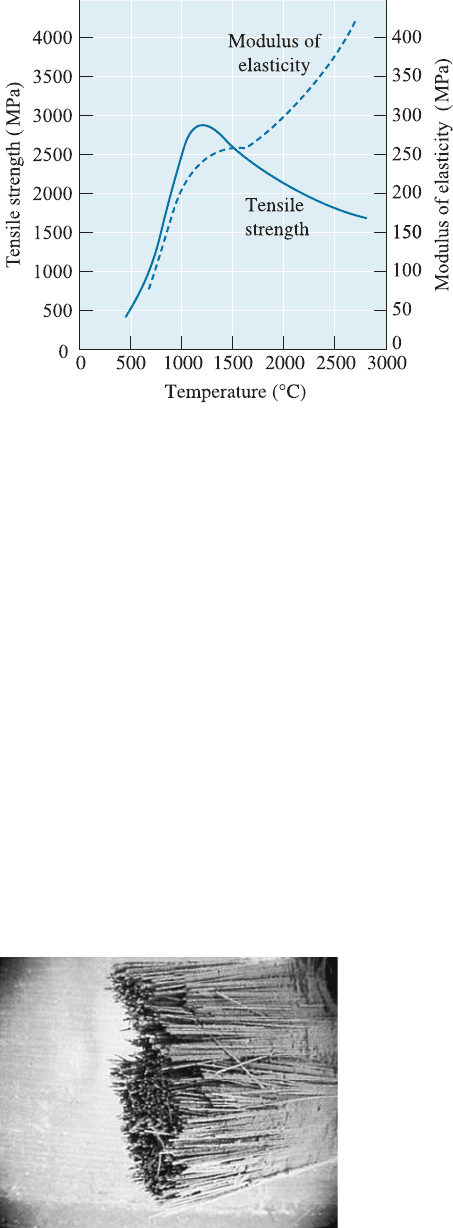
Arranging the Fibers Exceptio nally fine filaments are bundled together as rovings,
yarns, or tows. In yarns, as many as 10,000 filaments are twisted together to produce
the fiber. A tow contains a few hundred to more than 100,000 untwisted filaments
(Figure 17-20). Rovings are untwisted bundles of filaments, yarns, or tows.
Often, fibers are chopped into short lengths of 1 cm or less. These fibers, also called
staples, are easily incorporated into the matrix and are typical of the sheet-molding and
bulk-molding compounds for polymer-matrix composites. The fibers often are present
in the composite in a random orientation.
Long or continuous fibers for polymer-matrix composites can be processed into
mats or fabrics. Mats contain non-woven, randomly oriented fibers loosely held
together by a polymer resin. The fibers can also be woven, braided, or knitted into two-
dimensional or three-dimensional fabrics. The fabrics are then impregnated with a pol-
ymer resin. The resins at this point in the processing have not yet been completely
polymerized; these mats or fabrics are called prepregs.
When unidirectionally aligned fibers are to be introduced into a polymer matrix,
tapes may be produced. Individual fibers can be unwound from spools onto a mandrel,
which determines the spacing of the individual fibers, and prepregged with a polymer
resin. These tapes, only one fiber diameter thick, may be up to 120 cm wide. Figure 17-21
illustrates that tapes can also be produced by covering the fibers with upper and lower
layers of metal foil that are then joined by di¤usion bonding.
Figure 17-19
The effect of heat-treatment
temperature on the strength and
modulus of elasticity of carbon
fibers.
Figure 17-20
A scanning electron micrograph of a carbon tow
containing many individual carbon filaments
(200).
C HA P T E R 1 7 Composites: Teamwork and Synergy in Materials566
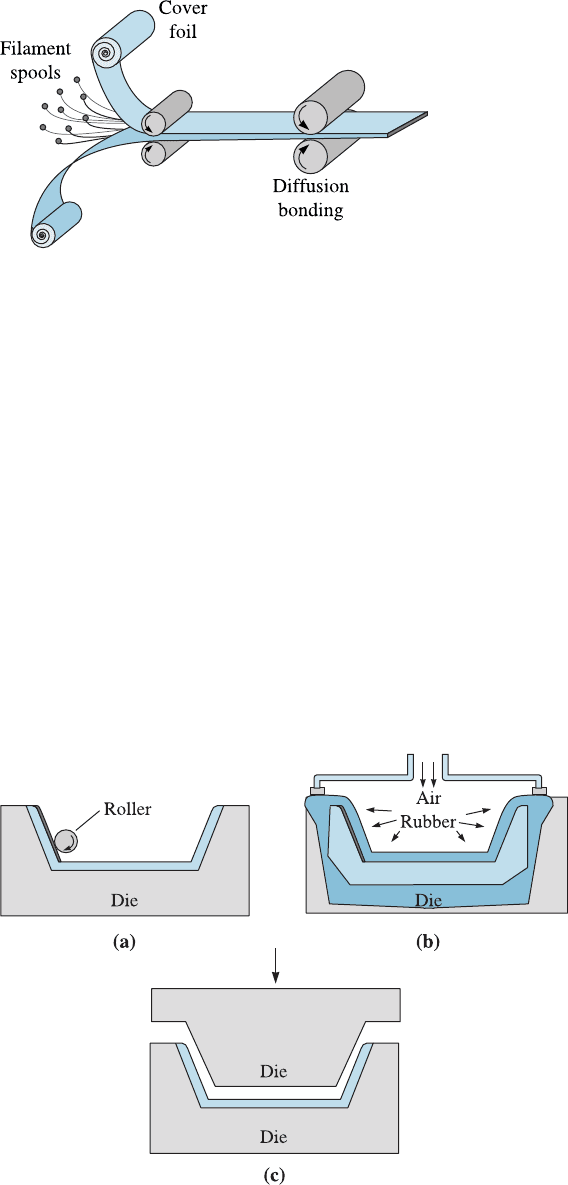
Producing the Composite A variety of methods for producing composite parts are
used, depending on the application and materials. Short fiber-reinforced composites are
normally formed by mixing the fibers with a liquid or plastic matrix, then using rela-
tively conventional techniques such as injection molding for polymer-base composites
or casting for metal-matrix composites. Polymer matrix composites can also be pro-
duced by a spray-up method, in which short fibers mixed with a resin are sprayed
against a form and cured.
Special techniques, however, have been devised for producing composites using
continuous fibers, either in unidirectionally aligned, mat, or fabric form (Figure 17-22).
In hand lay-up techniques, the tapes, mats, or fabrics are placed against a form, satu-
rated with a polymer resin, rolled to assure good contact and freedom from porosity,
and finally cured. Fiberglass car and truck bodies might be made in this manner, which
is generally slow and labor intensive.
Tapes and fabrics can also be placed in a die and formed by bag molding. High-
pressure gases or a vacuum are introduced to force the individual plies together so that
good bonding is achieved during curing. Large polymer matrix components for the
skins of military aircraft have been produced by these techniques. In matched die
Figure 17-21
Production of fiber tapes by
encasing fibers between metal cover
sheets by diffusion bonding.
Figure 17-22 Producing composite shapes in dies by (a) hand lay-up, (b) pressure bag
molding, and (c) matched die molding.
17-5 Manufacturing Fibers and Composites 567

molding, short fibers or mats are placed into a two-part die; when the die is closed, the
composite shape is formed.
Filament wind ing is used to produce products such as pressure tanks and rocket
motor castings (Figure 17-23). Fibers are wrapped around a form or mandre l to grad-
ually build up a hollow shape that may be even several feet in thick ness. The filament
can be dipped in the polymer-matrix resin prior to winding, or the resin can be im-
pregnated around the fiber during or after winding. Curing completes the production of
the composite part.
Pultrusion is used to form a simple-shaped product with a constant cross section,
such as round, rectangular, pipe, plate, or sheet shapes (Figure 17-24). Fibers or mats
are drawn from spools, passed through a polymer resin bath for impregnation, and
gathered together to produce a particular shape before entering a heated die for curing.
Curing of the resin is accomplished almost immediately, so a continuous product is
produced. The pultruded stock can subsequently be formed into somewhat more com-
plicated shapes, such as fishing poles, golf club shafts, and ski poles.
Metal-matrix composites with continuous fibers are more di‰cult to produce than
are the polymer-matrix composites. Casting processes that force liquid around the fibers
using capillary rise, pressure casting, vacuum infiltration, or continuous casting are
used. Various solid-state compaction processes can also be used.
17-6 Fiber-Reinforced Systems and Applications
Before completing our discussion of fiber-reinforced composites, let’s look at the
behavior and applications of some of the most common of these materials. Figure 17-25
compares the specific modulus and specific strength of several composites with those of
Figure 17-23
Producing composite shapes by filament winding.
Figure 17-24 Producing composite shapes by pultrusion.
C HA P T E R 1 7 Composites: Teamwork and Synergy in Materials568
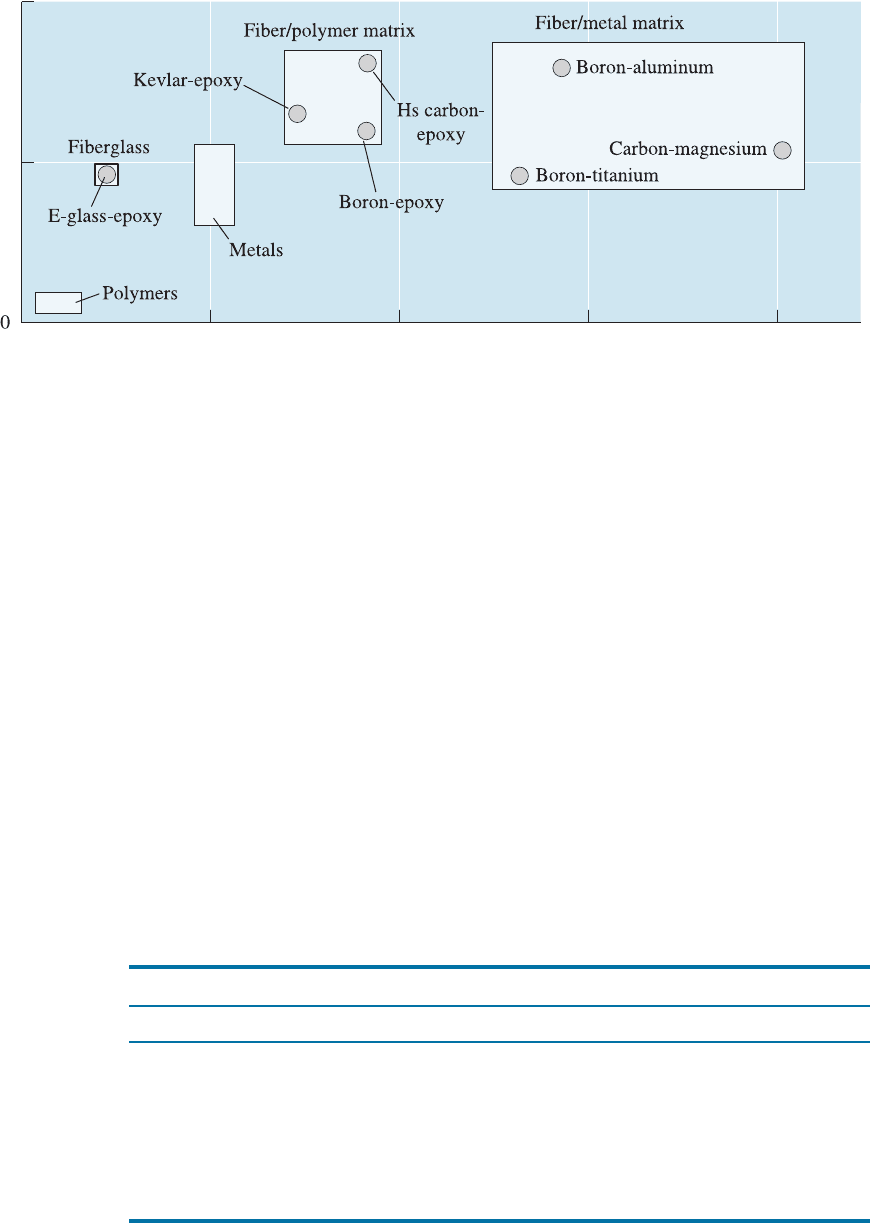
metals and polymers. Note that the values in this figure are lower than those in Fig-
ure 17-14, since we are now looking at the composite, not just the fiber.
Advanced Composites The term advanced composites is often used when the compo-
site is intended to provide service in very critical applications, as in the aerospace
industry (Table 17-3). The advanced composites normally are polymer–matrix compo-
sites reinforced with high-strength polymer, metal, or ceramic fibers. Carbon fibers are
used extensively where particularly good sti¤ness is required; aramid—and, to an even
greater extent, polyethylene—fibers are better suited to high-strength applications in
which toughness and damage resistance are more important. Unfortunately, the poly-
mer fibers lose their strength at relatively low temperatures, as do all of the polymer
matrices (Figure 17-26 on the next page).
The advanced composites are also frequently used for sporting goods. Tennis
rackets, golf clubs, skis, ski poles, and fishing poles often contain carbon or aramid fi-
bers because the higher sti¤ness provides better performance. In the case of golf clubs,
carbon fibers allow less weight in the shaft and therefore more weight in the head.
Fabric reinforced with polyethylene fibers is used for lightweight sail s for racing yachts.
A unique application for aramid fiber composites is armor. Tough Kevlar
TM
com-
posites provide better ballistic protection than other materials, making them suitable
for lightweight, flexible bulletproof clothing.
Specific strength (3 10
6
cm)
Specific modulus (3 10
8
cm)
2.5
2.5 5 7.5 10
5
Figure 17-25 A comparison of the specific modulus and specific strength of several composite
materials with those of metals and polymers.
TABLE 17-3 9 Examples of fiber-reinforced materials and applications
Material Applications
Borsic aluminum Fan blades in engines, other aircraft and aerospace applications
Kevlar
TM
-epoxy and
Kevlar
TM
-polyester
Aircraft, aerospace applications (including space shuttle), boat hulls, sporting
goods (including tennis rackets, golf club shafts, fishing rods), flak jackets
Graphite-polymer Aerospace and automotive applications, sporting goods
Glass-polymer Lightweight automotive applications, water and marine applications, corrosion-
resistant applications, sporting goods equipment, aircraft and aerospace
components
17-6 Fiber-Reinforced Systems and Applications 569
